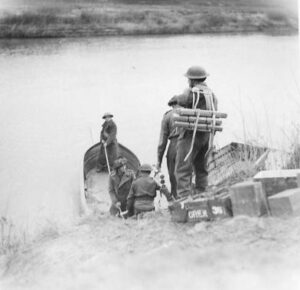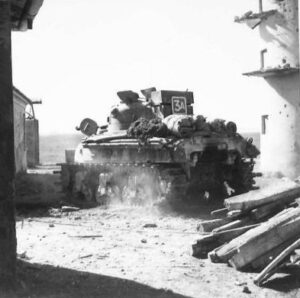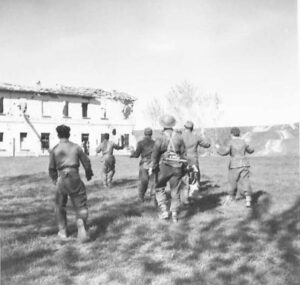It was hoped to destroy the German armies south of the Po by a pincers movement, with the Eighth Army advancing on a general axis through Argenta, Ferrara, and Bodeno, and the US led Fifth Army attacking north through Bologna to the river near Ostiglia. The Fifth Army was then to drive towards Verona and cut off the whole of the enemy forces in north-west Italy. To enable the maximum use to be made of the Allied Air Forces, the attacks were to be on different dates, the Eighth Army going into action at least three days before the Fifth Army, which it was thought would draw off any enemy reserves from the Fifth Army front. The Eighth Army, after reaching the Po, was to drive north-east towards Venice and Trieste.
A part of the British plan was that before the main attack by the Eighth Army began, the 56th (London) Division, which was now back to full strength with the 24th Guards Brigade replacing the disbanded 168 Brigade, should outflank the German defensive lines on the Senio, Santerno, and Sillaro, Rivers, with the help of the 2nd Commando Brigade. That accomplished, the Army was to force the narrow Argenta Gap between Argenta and Lake Comacchio, and destroy the bulk of the German armies before they could get back across the Po. This move entailed a crossing of the River Reno near where it flowed into the lake, and the 1st Battalion London Irish was given the task of forcing a crossing four days before D Day for the Army. The battalion planned to go over on a two-company front, supported by a considerable artillery programme. The 9th Royal Fusiliers were to pass through when the initial bridgehead had been secured, and the whole advance was to swing west, following the line of the Reno, thus turning the German lines along the Senio, and Santerno Rivers, both of which flowed into the Reno west of San Alberto. The role of the London Irish was a vital one, and on its success or failure might well have depended the progress of the Army’s offensive.
LAKE COMACCHIO

Two days were spent in reconnaissance, preparations, and rehearsals in assault-boats. Every man knew the plan and the part he had to play. The atmosphere was one of sober confidence and quiet determination. At nine o’clock on the night of April 5, the two assaulting companies, ‘B’ and ‘C’, were in their forming-up lines just behind the flood-banks which screened them from the enemy. Assault-boats were ready, rations and ammunition had been dumped in large quantities, and every possible step taken to ensure the success of the operation. It was a lovely spring evening, and not a sound disturbed the stillness of the countryside. The Germans, it seemed, suspected nothing.
At 0115 hours a Bofors shell lit up the darkness. That was the signal, and was followed by the most enormous and deafening crash as fire was opened from six Field Regiments, two Medium Regiments, a heavy battery, four-point-two-inch mortars, three-inch mortars, and machine-guns. ‘B’ Company, commanded by Captain N Dorrity, attacked on the right, and ‘C’ Company, under Major MVS Boswell, on the left. The attack by Captain Dorrity’s men was in two parts. No.11 Platoon, under Lieutenant C Hibbert, had crossed the river in the afternoon and hid in an Italian partisan post on the north bank. Facing them was a German post about a hundred and fifty yards away guarding the junction of the Reno’s north bank with Lake Comacchio in its south-west corner. No.11 Platoon had to work round the river bend and smash the enemy post when the preliminary bombardment opened. The rest of the company were to cross about two hundred yards west of the post and then to advance north. Their first big objective was a rice factory, a known enemy strongpoint. ‘C’ Company were to cross west of ‘B’ on a two-platoon front, swing left, and advance westwards along the river bank, conforming with ‘B’ Company’s advance. German dugouts on the bank had to be cleared.

The main crossing went very well. The enemy were surprised, and prisoners soon began to come in. The weight of the artillery fire must have played havoc with their communications, as their defensive fire was too late to be of any value. On the right, Lieutenant C Hibbert and his platoon were unable to get at the enemy post, which was surrounded by a minefield and barbed wire well covered by machine-guns. An attempt was made to get round the mines and the wire by wading out into the lake, which luckily was shallow. There was no cover, and many men fell. It was only after fifteen of them, including Lieutenant Hibbert, had been wounded, that the attempt was abandoned. ‘B’ Company cleared many Huns from their bank-side dugouts and then pushed on swiftly to, the rice factory. Here after a short scrap they took twenty prisoners and two seventy-five-millimetre guns. Captain Dorrity had not waited for 11 Platoon, and by then he was out of touch by wireless. Without news of his third platoon he decided to push on, and by dawn the company had reached its final objective about a thousand yards west of the factory, a very fine and workmanlike feat.
Meanwhile ‘C’ Company had been having a stickier time. Two boats were lost in the river crossing, and shortly after landing on the other bank Lieutenant Foley, another South African officer well liked by his men, was hit by a burst of Spandau fire and had to be sent back. At 0230 hours on the 6th, ‘B’ Company were at the rice factory and ‘C’ Company on the north bank at Prato del Pozzo. It was impossible for them to press along the bank westwards because the strongly entrenched Germans completely dominated the flat, open ground. There was also a dense minefield between Prato del Pozzo and the factory. After several costly attempts to get through, Major Boswell decided to wait for tank support, which he could expect at dusk. The German post unsuccessfully attacked by 11 Platoon was still holding out though it was completely isolated.

The sappers had to build by dawn a raft on which Shermans could be floated over the river to help the infantry. From the protection of their post the enemy “bazookered” the raft, in the sinking of which several sappers were lost. It was not until 0800 hours that the fourteen Germans in the post surrendered. They realised their position was hopeless, and their decision was hastened by a few blasts from a tank on the south bank. The delay meant that the armour could not possibly reach the forward companies until 1600 hours. At 0230 hours on the 6th the Commanding Officer decided to push ‘A’ Company through ‘B’ Company and to swing down to the river and cut off the Germans still holding out in front of ‘C’ Company.
ACROSS THE RENO
Thanks to the fine work of the pioneer platoon and a company of London Scots, a very efficient ferry service was working and continued to operate throughout the night, often under accurate shelling and mortaring. The supply teams had to provide sufficient ammunition, water, food, wireless batteries, and other essentials to keep the battalion going for forty-eight hours. Everything went over in a steady stream, and this was due to the efforts of the bandsmen, the sanitation men, the Quartermaster’s staff, the cobblers, and all the variety of employed men who acted as carriers. Two sections of the band accompanied the assaulting companies as extra ammunition carriers, so that every man in the battalion did his share. The ferry was used at 0500 hours to get ‘A’ Company over. Commanded by Major H St. G Gallaher, who had returned to the battalion on recovering from earlier wounds, the company had to advance at a fast rate to avoid being caught on the open ground in daylight. Dawn was just breaking when Major Gallaher reached Captain Dorrity in the rice factory.
Two platoons of ‘A’ Company went on, but enemy fire slowed them down. No. 7 Platoon, under Lieutenant C Cropper and Sergeant Lloyd, just managed to get into a farmhouse, where they spent an uncomfortable twelve hours with the enemy firmly fixed in all the surrounding dwellings. It was a keen and dangerous game of hide-and-seek. No. 9 Platoon, under Lieutenant Ferguson, tried to dig in the open, but their slits filled with water. The flat ground aided observation, and German bullets forced the Commanders of ‘A’ and ‘B’ Companies to spend many hours in a pigsty. Dawn thus found the London Irish well established on the other side of the river with a bridgehead two thousand five hundred yards in depth, which they were able to hold until tanks arrived. The expected German counter-attack never came, and it was apparent that the suddenness of the attack and the disruption of the enemy’s communications made them unable to stage a comeback. Over a hundred prisoners were taken during the night, and they were ferried back to battalion headquarters for interrogation.
Progress along the riverbank continued for seven days, with stiff opposition from various strong points. No.8 Platoon, under Lieutenant A Hunter, with Sergeant G. Jiggins platoon sergeant, dealt most convincingly with one of these and succeeded in linking up with troops from another division and trapping a number of Germans. The chase went on and was reminiscent of the Sicily days. Indeed, one old campaigner remarked quite truthfully: “This is where we came in.” German leaflets: “The Po River is waiting for you,” were a reminder, however, that there was just one more river to cross. The chief trouble for the 56th (London) Division was that its axis was along a poor road along the banks above the floods north of the Reno.
On the evening of the 12th, C Company, now only two platoons strong, attacked Pallazzo Tamba, and were beaten back. Another attempt was made in the morning, and eight prisoners were taken. Fire from a self-propelled gun caused several casualties and the platoons had to withdraw. It was there that Sergeant JE Graham was killed. The company made a third attack at midday, but were again unable to crack the opposition and suffered more casualties, which weakened them further. The objective was finally taken by D Company, with the help of dive-bombers.
The crossing of the Reno was an unqualified success. Careful planning, detailed reconnaissances, hard training, and bold execution paid a rich dividend and earned for the London Irish fresh laurels and the congratulations of the Divisional Commander on what he described as a model operation.